Written by
Amanda WongCan't Delete Files/Folders from USB on Mac? Here Are Solutions!
Summary: You can find workable solutions to fix can't files from USB on Mac in this post, and know the possible causes. It also tells how to remove files from USB flash drive on Mac. For an NTFS formatted drive, you can use iBoysoft NTFS for Mac to delete files from the USB.
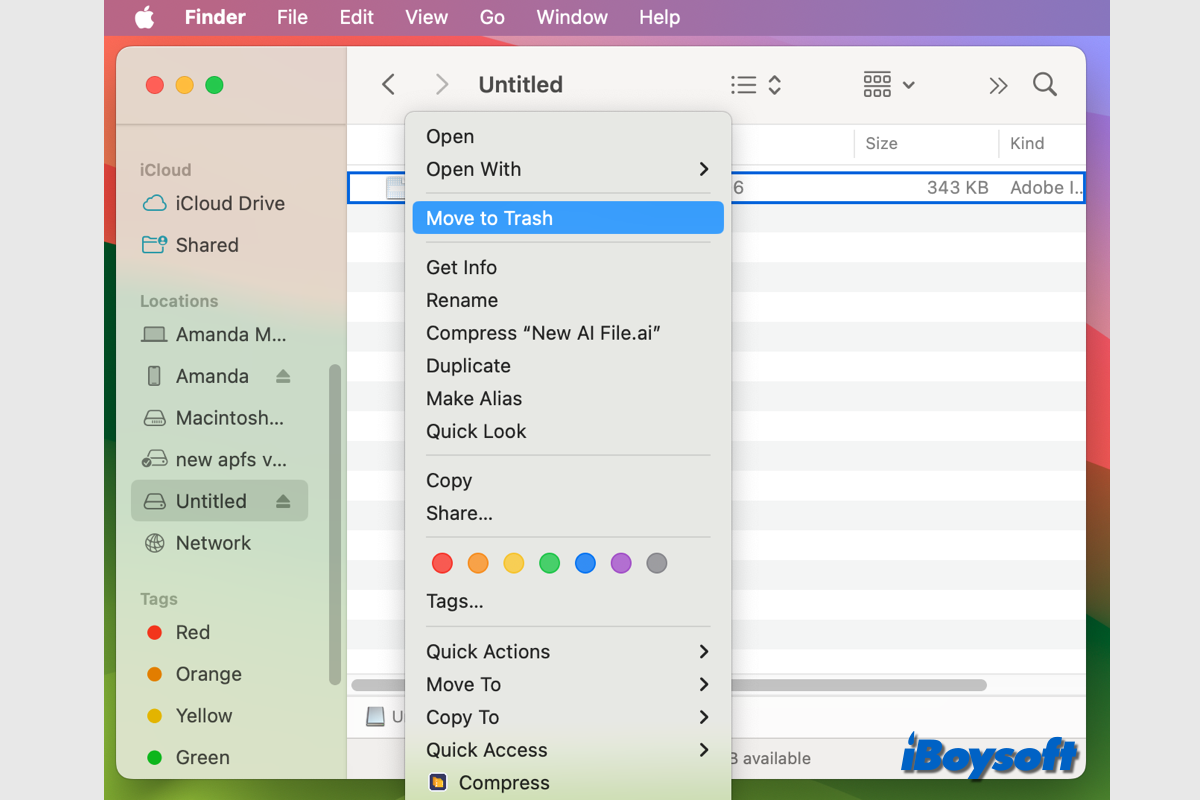
Generally, after you connect the USB flash drive to your Mac, you can access the drive on Mac from Finder and Desktop and manage files/folders on it. Unexpectedly, when you attempt to remove files from the USB flash drive, it fails.
I got this USB stick with some music on it. I copied the content on my machine. Two days later I wanted to delete the data from the USB drive. The Move to trash option is missing, and if I try to drag and drop this into Trash can it doesn't work. This message pops up: The item "[file name]" can't be moved to the Trash because it can't be deleted. What is causing the issue and how do I resolve it?
When it prevents you from deleting files on the USB drive on a Mac, it may prompt other error messages or nothing at all. Don't directly reformat the USB drive before you have identified the root cause of the issue and tried other effective methods.
9 tips to fix can't delete files from USB on Mac
It is frustrating when you find that you can't delete files/folders from USB drives on a Mac. However, it is not a big issue, and you can try 8 workable solutions to troubleshoot it. Now, let's dive into each method in detail.
- Check whether the file system is compatible
- Enable NTFS permission on Mac
- Change file permission to read & write
- Enable ignore ownership on this volume
- Make sure the file is not in use
- Restart the Mac and reconnect the USB drive
- Force delete files with Terminal
- Run First Aid on the USB drive
- Format the USB flash drive
Check whether the file system is compatible
The incompatible file system of the USB flash drives and other external disks is one of the most common reasons why you can't write to a disk on a Mac especially if you use the USB flash drive for Windows. Therefore, it is necessary to check the drive format when you can't delete files/folders from it.
- Launch Disk Utility from the Apple menu > Applications > Utilities.
- Click the connected USB drive from the left list.
- Check the disk format on the right side, under the drive name.
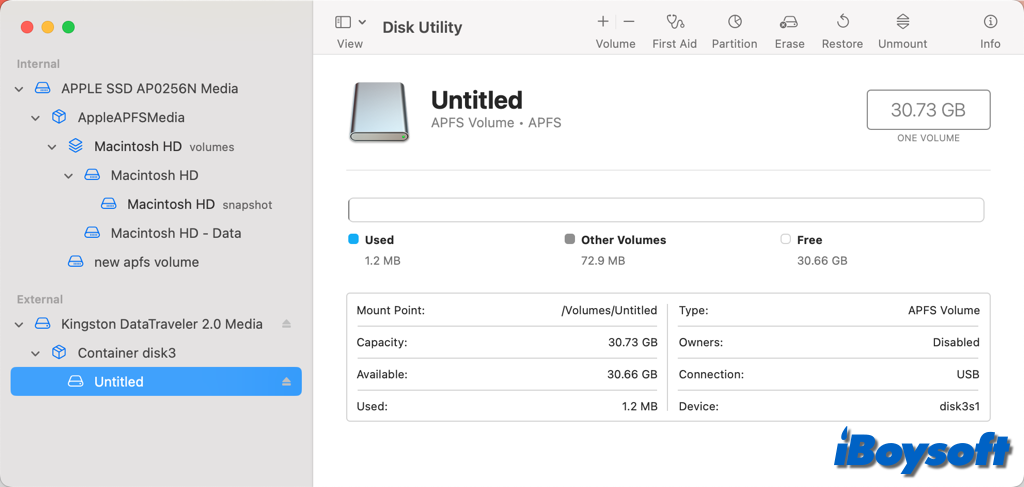
Enable NTFS permission on Mac
You can't delete files from an NTFS-formatted USB flash drive on Mac by default given that NTFS is read-only on Mac. In addition to reformatting the USB drive with APFS/HFS+/exFAT/FAT32 to make it compatible with macOS, you can enable NTFS permission on Mac with NTFS for Mac such as iBoysoft NTFS for Mac.
iBoysoft NTFS for Mac automatically mounts the NTFS drive on Mac in read-write mode. It mounts an NTFS disk in the Finder, Disk Utility, and on the desktop as a physical volume rather than a virtual one. You can fully access the NTFS USB drive to read and write files on it. Only a few steps are needed.
How to delete files/folders from NTFS on Mac:
Step 1. Download and install iBoysoft NTFS for Mac on your device.
Step 2. Connect the NTFS USB drive to your Mac.
Step 3. Open iBoysoft NTFS for Mac, select the NTFS drive, and click Open.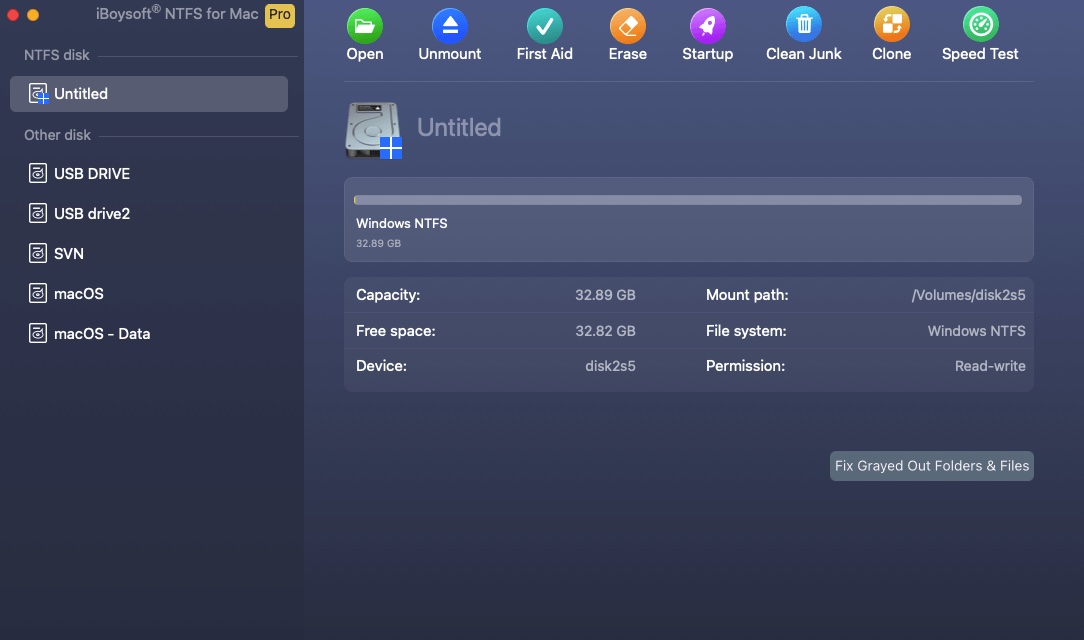
Step 4. Access the NTFS drive and delete unwanted files.
If you have deleted the files from the USB drive on Mac with iBoysoft NTFS for Mac, please share this post to let more people know about this solution!
Change file permission to read & write
On a Mac, incorrect permissions may be the cause when you are unable to remove it from USB. To delete files from your USB drive, please confirm that you have the right permissions. Follow the steps to check and change file permissions:
- Right-click the USB drive on the Desktop or in Finder and choose Get Info.
- Click the Sharing & Permissions section to expand it.
- Click the yellow padlock to unlock the pane.
- Change the privilege of your account to Read & Write.
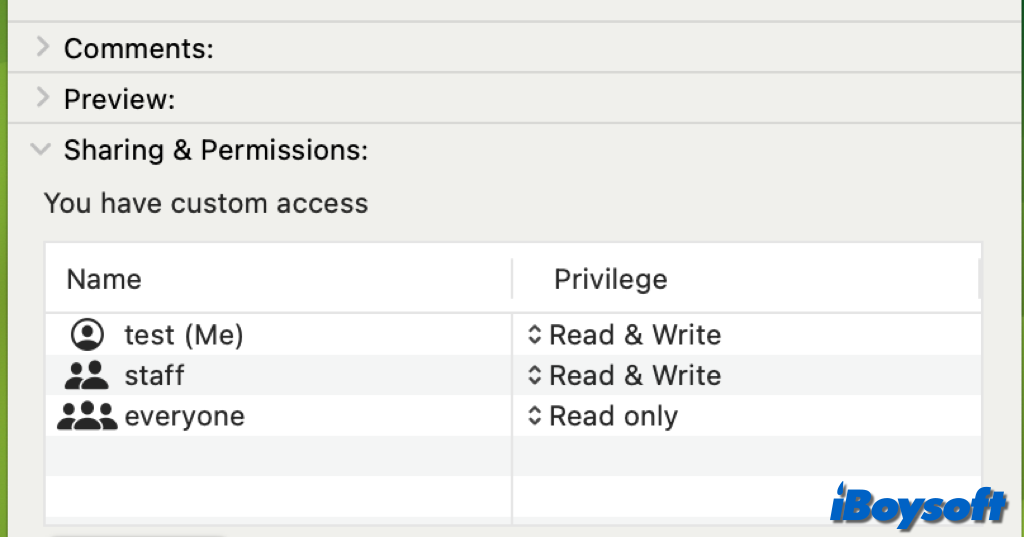
Enable ignore ownership on this volume
On APFS and Mac OS Extended disk, there is an option called ignore ownership on this volume, if you are not the owner of the files you want to delete from USB, you should enable the "Ignore ownership on this volume" so that you can delete the files from the USB drive.
- Right-click the disk icon in Finder's sidebar and choose Get Info.
- Scroll down to the bottom to click Sharing & Permissions.
- Click the padlock and unlock it with your password.
- Check the box of Ignore ownership on this volume.
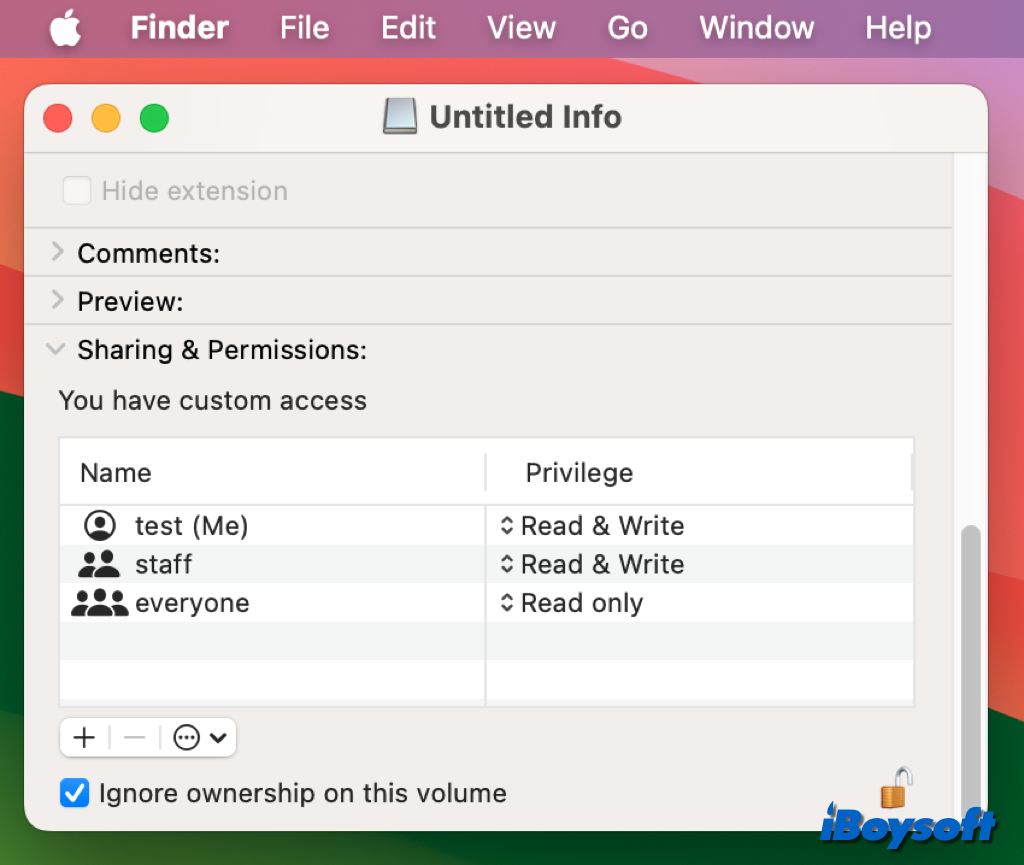
Make sure the file is not in use
When you can't delete files from USB on Mac, the reason could be that the file you intend to delete is in use, and you may receive the error message "The operation can't be completed because the item is in use," you should close the program that is using the target file, and try to delete it again.
Restart the Mac and reconnect the USB drive
Restarting your Mac is always worth a shot when the Mac has some minor issues. It closes all apps and processes and boots up your Mac again. Restarting the Mac could isolate temporary system-related errors or some problematic apps that prevent you from deleting files/folders from the USB drive on Mac.
After restarting the Mac, you can try to reconnect the USB drive to your Mac, and make sure the USB port, the USB cable, the USB hub, etc., are not defective. Then, try to delete files from the USB drive on Mac again.
Force delete files with Terminal
If the methods above fail to help you delete files from the USB on Mac, you can try to run Terminal commands to force delete unwanted files. Here's how:
- Go to the Utilities folder and open Terminal.
- Type the following command and drag the target file into the Terminal window. rm -f file-name
- Hit the Enter key to execute the command to delete the file.
Run First Aid on the USB drive
If the USB flash drive is corrupted, it could also cause some errors such as can't deleting files from the USB drive on Mac. When your internal or external disk performs abnormally, you can run Disk Utility First Aid to check and repair disks on Mac.
- Make sure the USB flash drive is connected to your Mac.
- Open the Disk Utility app from the macOS Utilities folder.
- Select the USB drive on the left and click First Aid in the toolbar.
- Click Run to start and click Done when the process completes.
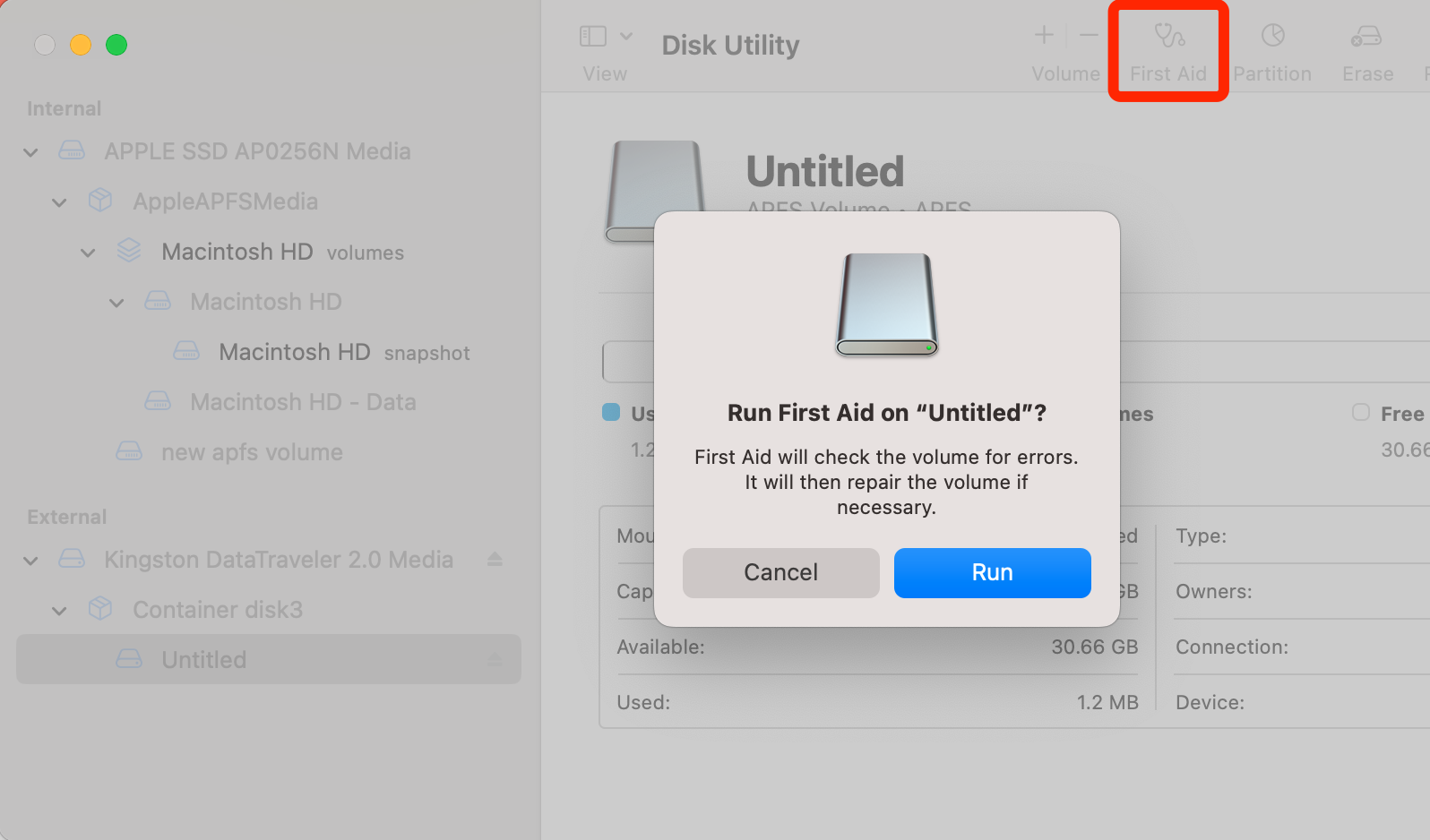
Format the USB flash drive
Perhaps, you can't repair the USB flash drive with First Aid, then the drive could be severely damaged. The last resort you can try is to reformat the USB flash drive on Mac to fix logical disk errors. It will delete all drive data, therefore, you can back up the important files and then reformat it.
- Connect the USB drive and launch Disk Utility.
- Select the USB drive on the left list.
- Click the Erase button on the toolbar.
- Enter a name and choose a file system depending on the OS you want to use the disk for.
- Click Erase again.
If you can delete files from the USB drive on Mac after applying the methods above, share this post to help more people!
Why can't delete files from USB on Mac?
When you find you can't delete files/folders from the USB flash drive on your Mac, you may want to figure out the reason. Several possible causes prevent you from removing files from the USB drive on Mac:
Incompatible file system. If the USB flash drive is NTFS-formattted, you can't manage data on it including deleting files from it. You can either reformat the drive to a macOS-compatible one or use third-party NTFS for Mac such as iBoysoft NTFS for Mac.
Permission issues. The APFS or Mac OS Extended USB flash drive could be read-only to you so you can't delete files from it, you need to change permission on Mac to make sure you have permission to delete the files from the flash drive.
The file you want to delete is in use. When a file is used by other programs, you can't delete it. You should make sure there is no application and other hidden background processes are using the file so that you can delete it.
Connection issues. Sometimes the problem could be caused by a loose or broken USB connection. Make sure the USB drive is firmly connected to your Mac and try using an alternative USB port or cable.
Damages to the flash drive. Perhaps the USB flash drive is damaged so you can't delete files from it now. To fix this issue, you can run First Aid on the problematic USB drive to reformat it.
How to remove files/folders from USB on Mac?
When some files/folders on the USB flash drive are unwanted, you can delete them to manage the drive data and release more disk space. If you want to remove files from USB on Mac, there are multiple ways you can choose:
- Right-click unwanted files and choose Move to Trash, then click Trash > Empty Trash.
- Directly drag the files you want to delete into the Trash and Empty Trash.
- Choose target files/folders and press Command + Delete to move them to Trash, then Empty Trash.
- Select the files/folders you want to remove and press Command + Option + Delete to permanently delete them.
- Format the USB flash drive in Disk Utility to permanently delete all files.
Don't forget to share this post with people in need!

